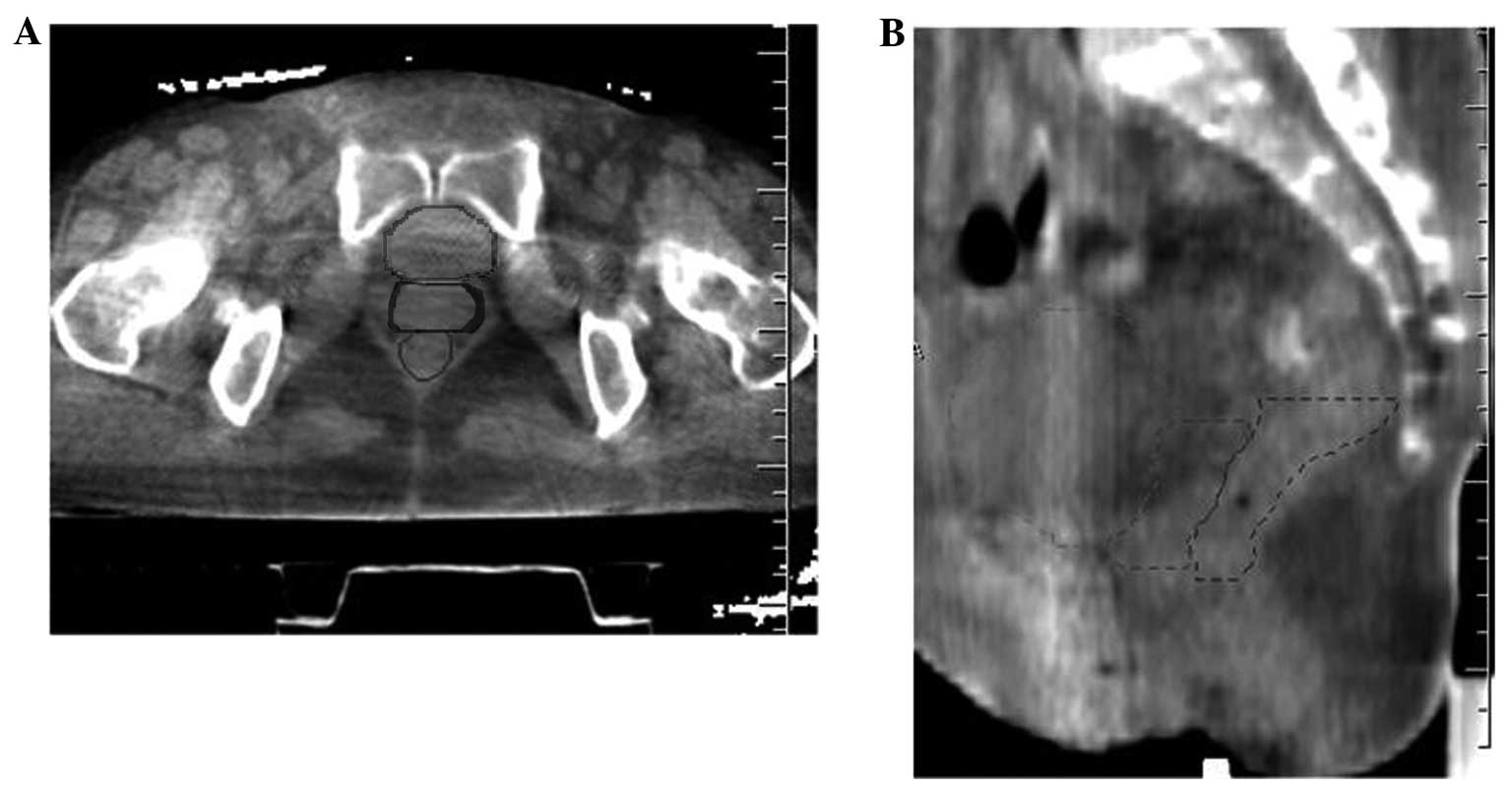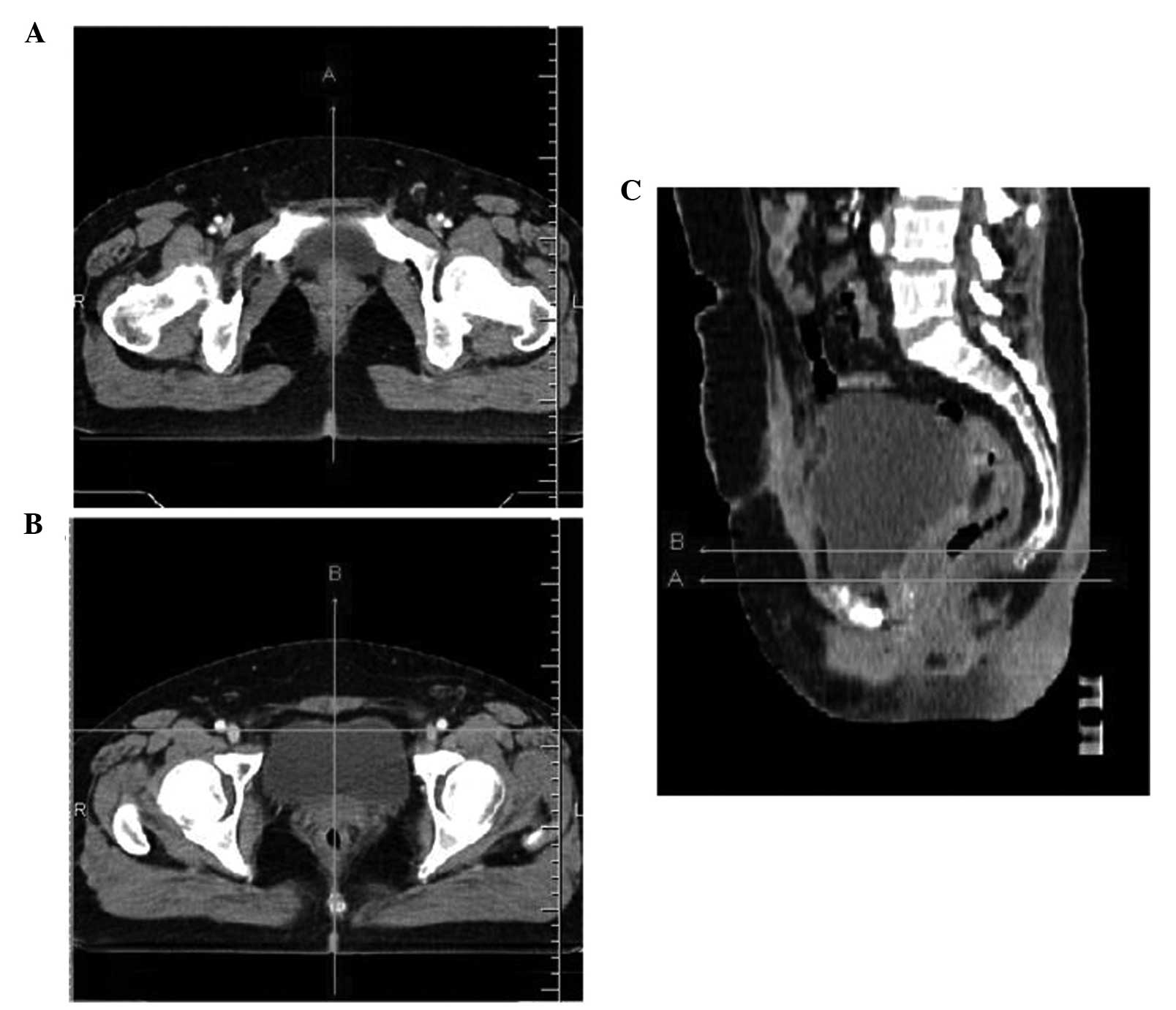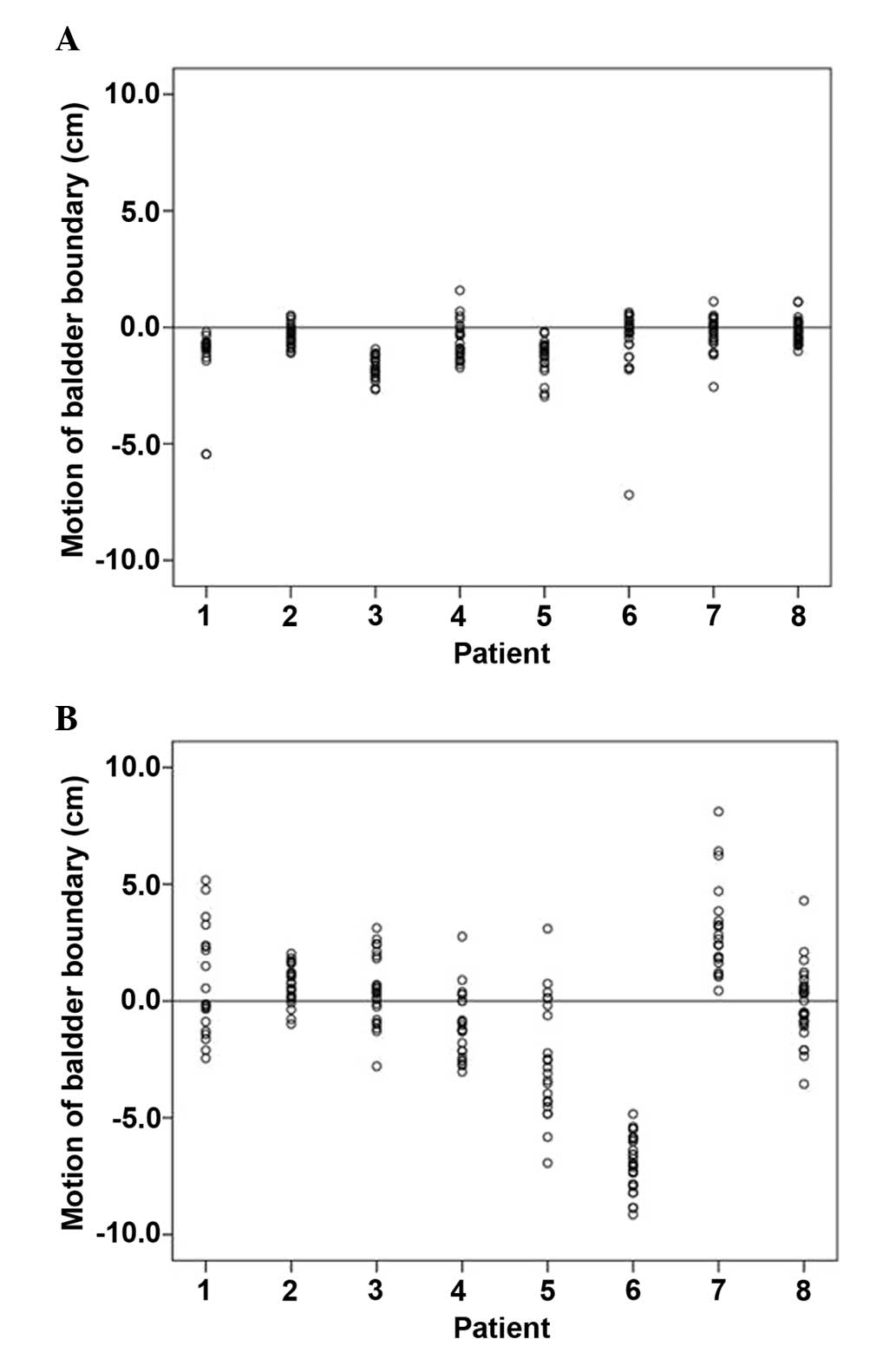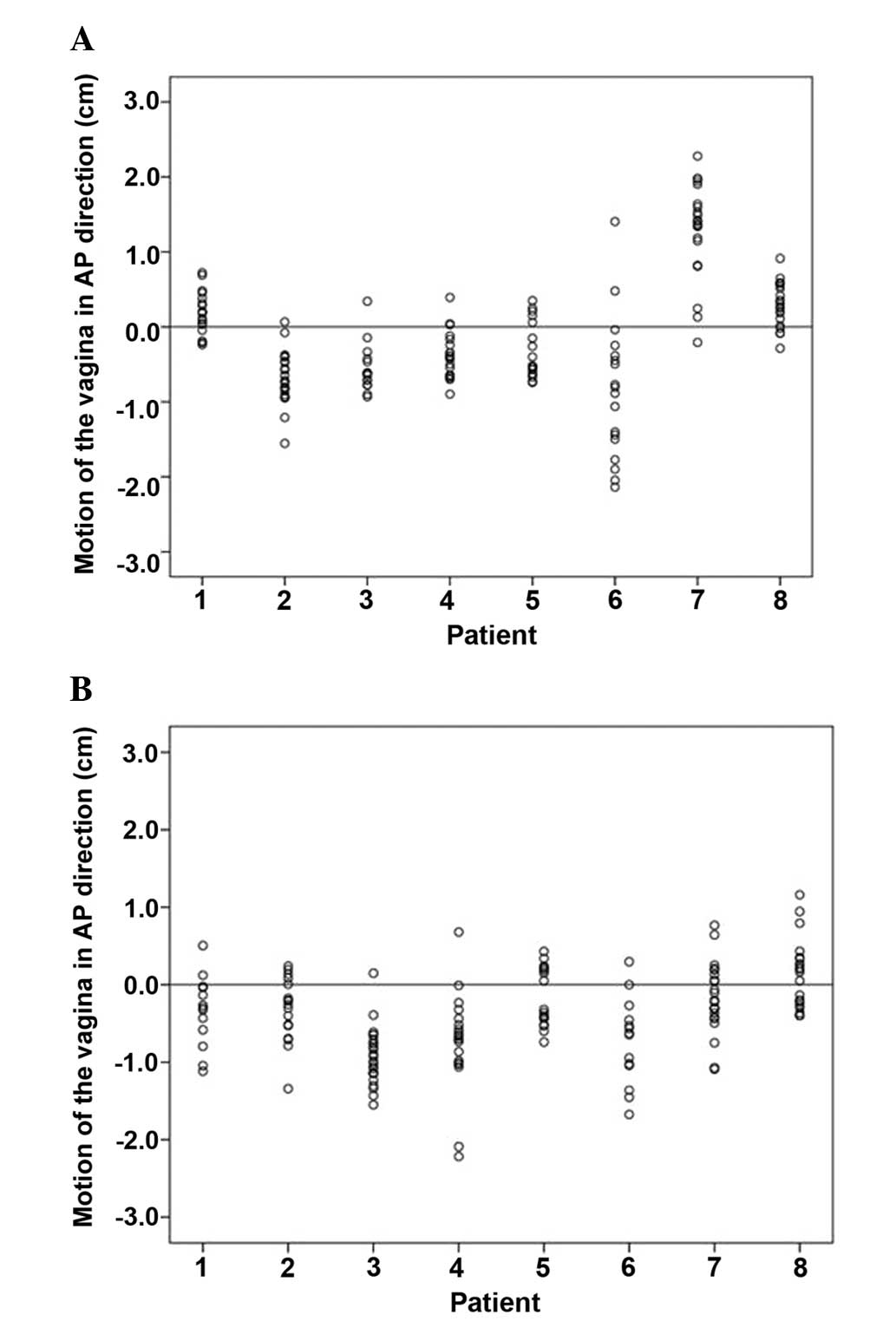|
1
|
Heron DE, Gerszten K, Selvaraj RN, et al:
Conventional 3D conformal versus intensity-modulated radiotherapy
for the adjuvant treatment of gynecologic malignancies: A
comparative dosimetric study of dose-volume histograms. Gynecol
Oncol. 91:39–45. 2003. View Article : Google Scholar : PubMed/NCBI
|
|
2
|
Mundt AJ, Lujan AE, Rotmensch J, Waggoner
SE, Yamada SD, Fleming G and Roeske JC: Intensity-modulated whole
pelvic radiotherapy in women with gynecologic malignancies. Int J
Radiat Oncol Biol Phys. 52:1330–1337. 2002. View Article : Google Scholar : PubMed/NCBI
|
|
3
|
Portelance L, Chao KS, Grigsby PW, Bennet
H and Low D: Intensity-modulated radiation therapy (IMRT) reduces
small bowel, rectum and bladder doses in patients with cervical
cancer receiving pelvic and para-aortic irradiation. Int J Radiat
Oncol Biol Phys. 51:261–266. 2001. View Article : Google Scholar : PubMed/NCBI
|
|
4
|
Roeske JC, Lujan A, Rotmensch J, Waggoner
SE, Yamada D and Mundt AJ: Intensity-modulated whole pelvic
radiation therapy in patients with gynecologic malignancies. Int J
Radiat Oncol Biol Phys. 48:1613–1621. 2000. View Article : Google Scholar : PubMed/NCBI
|
|
5
|
van de Bunt L, van der Heide UA, Ketelaars
M, de Kort GA and Jürgenliemk-Schulz IM: Conventional, conformal
and intensity-modulated radiation therapy treatment planning of
external beam radiotherapy for cervical cancer: The impact of tumor
regression. Int J Radiat Oncol Biol Phys. 64:189–196. 2006.
View Article : Google Scholar : PubMed/NCBI
|
|
6
|
Brixey CJ, Roeske JC, Lujan AE, Yamada SD,
Rotmensch J and Mundt AJ: Impact of intensity-modulated
radiotherapy on acute hematologic toxicity in women with
gynecologic malignancies. Int J Radiat Oncol Biol Phys.
54:1388–1396. 2002. View Article : Google Scholar : PubMed/NCBI
|
|
7
|
Mundt AJ, Mell LK and Roeske JC:
Preliminary analysis of chronic gastrointestinal toxicity in
gynecology patients treated with intensity-modulated whole pelvic
radiation therapy. Int J Radiat Oncol Biol Phys. 56:1354–1360.
2003. View Article : Google Scholar : PubMed/NCBI
|
|
8
|
Beriwal S, Jain SK, Heron DE, Kim H,
Gerszten K, Edwards RP and Kelley JL: Clinical outcome with
adjuvant treatment of endometrial carcinoma using
intensity-modulated radiation therapy. Gynecol Oncol. 102:195–199.
2006. View Article : Google Scholar : PubMed/NCBI
|
|
9
|
Salama JK, Mundt AJ, Roeske J and Mehta N:
Preliminary outcome and toxicity report of extended-field,
intensity-modulated radiation therapy for gynecologic malignancies.
Int J Radiat Oncol Biol Phys. 65:1170–1176. 2006. View Article : Google Scholar : PubMed/NCBI
|
|
10
|
Beriwal S, Gan GN, Heron DE, Selvaraj RN,
Kim H, Lalonde R, Kelley JL and Edwards RP: Early clinical outcome
with concurrent chemotherapy and extended-field,
intensity-modulated radiotherapy for cervical cancer. Int J Radiat
Oncol Biol Phys. 68:166–171. 2007. View Article : Google Scholar : PubMed/NCBI
|
|
11
|
Small W Jr, Mell LK, Anderson P, et al:
Consensus guidelines for delineation of clinical target volume for
intensity-modulated pelvic radiotherapy in postoperative treatment
of endometrial and cervical cancer. Int J Radiat Oncol Biol Phys.
71:428–434. 2008. View Article : Google Scholar : PubMed/NCBI
|
|
12
|
Jhingran A, Salehpour M, Sam M, Levy L and
Eifel PJ: Vaginal motion and bladder and rectal volumes during
pelvic intensity-modulated radiation therapy after hysterectomy.
Int J Radiat Oncol Biol Phys. 82:256–262. 2012. View Article : Google Scholar : PubMed/NCBI
|
|
13
|
Taylor A and Powell ME: An assessment of
interfractional uterine and cervical motion: Implications for
radiotherapy target volume definition in gynaecological cancer.
Radiother Oncol. 88:250–257. 2008. View Article : Google Scholar : PubMed/NCBI
|
|
14
|
van de Bunt L, Jürgenliemk-Schulz IM, de
Kort GA, Roesink JM, Tersteeg RJ and van der Heide UA: Motion and
deformation of the target volumes during IMRT for cervical cancer.
What margins do we need? Radiother Oncol. 88:233–240. 2008.
View Article : Google Scholar : PubMed/NCBI
|
|
15
|
Haripotepornkul NH, Nath SK, Scanderbeg D,
Saenz C and Yashar CM: Evaluation of intra- and inter-fraction
movement of the cervix during intensity modulated radiation
therapy. Radiother Oncol. 98:347–351. 2011. View Article : Google Scholar : PubMed/NCBI
|
|
16
|
Buchali A, Koswig S, Dinges S, Rosenthal
P, Salk J, Lackner G, Böhmer D, Schlenger L and Budach V: Impact of
the filling status of the bladder and rectum on their integral dose
distribution and the movement of the uterus in the treatment
planning of gynaecological cancer. Radiother Oncol. 52:29–34. 1999.
View Article : Google Scholar : PubMed/NCBI
|
|
17
|
Ahmad R, Hoogeman MS, Quint S and Mens JW:
deP ree I and Heijmen BJ: Inter-fraction bladder filling variations
and time trends for cervical cancer patients assessed with a
portable 3-dimensional ultrasound bladder scanner. Radiother Oncol.
89:172–179. 2008. View Article : Google Scholar : PubMed/NCBI
|
|
18
|
Chan P, Dinniwell R, Haider MA, Cho YB,
Jaffray D, Lockwood G, Levin W, Manchul L, Fyles A and Milosevic M:
Inter- and intrafractional tumor and organ movement in patients
with cervical cancer undergoing radiotherapy, A cinematic-MRI
point-of-interest study. Int J Radiat Oncol Biol Phys.
70:1507–1515. 2008. View Article : Google Scholar : PubMed/NCBI
|
|
19
|
Kerkhof EM, van der Put RW, Raaymakers BW,
van der Heide UA, Jürgenliemk-Schulz IM and Lagendijk JJ:
Intrafraction motion in patients with cervical cancer: The benefit
of soft tissue registration using MRI. Radiother Oncol. 93:115–121.
2009. View Article : Google Scholar : PubMed/NCBI
|
|
20
|
Hammoud R, Patel SH, Pradhan D, Kim J,
Guan H, Li S and Movsas B: Examining margin reduction and its
impact on dose distribution for prostate cancer patients undergoing
daily cone-beam computed tomography. Int J Radiat Oncol Biol Phys.
71:265–273. 2008. View Article : Google Scholar : PubMed/NCBI
|
|
21
|
Showalter TN, Nawaz AO, Xiao Y, Galvin JM
and Valicenti RK: A cone beam CT-based study for clinical target
definition using pelvic anatomy during postprostatectomy
radiotherapy. Int J Radiat Oncol Biol Phys. 70:431–436. 2008.
View Article : Google Scholar : PubMed/NCBI
|
|
22
|
Brock KK, Hawkins M, Eccles C, Moseley JL,
Moseley DJ, Jaffray DA and Dawson LA: Improving image-guided target
localization through deformable registration. Acta Oncol.
47:1279–1285. 2008. View Article : Google Scholar : PubMed/NCBI
|
|
23
|
Ding GX, Duggan DM, Coffey CW, Deeley M,
Hallahan DE, Cmelak A and Malcolm A: A study on adaptive IMRT
treatment planning using kV cone-beam CT. Radiother Oncol.
85:116–125. 2007. View Article : Google Scholar : PubMed/NCBI
|
|
24
|
Kerkhof EM, Raaymakers BW, van der Heide
UA, van de Bunt L, Jürgenliemk-Schulz IM and Lagendijk JJ: Online
MRI guidance for healthy tissue sparing in patients with cervical
cancer: An IMRT planning study. Radiother Oncol. 88:241–249. 2008.
View Article : Google Scholar : PubMed/NCBI
|
|
25
|
Jürgenliemk-Schulz IM, Toet-Bosma MZ, de
Kort GA, Schreuder HW, Roesink JM, Tersteeg RJ and van der Heide
UA: Internal motion of the vagina after hysterectomy for
gynaecological cancer. Radiother Oncol. 98:244–248. 2011.
View Article : Google Scholar : PubMed/NCBI
|
|
26
|
Stam MR, van Lin EN, van der Vight LP,
Kaanders JH and Visser AG: Bladder filling variation during
radiation treatment of prostate cancer: Can the use of a bladder
ultrasound scanner and biofeedback optimize bladder filling? Int J
Radiat Oncol Biol Phys. 65:371–377. 2006. View Article : Google Scholar : PubMed/NCBI
|
|
27
|
O'Doherty UM, McNair HA, Norman AR, et al:
Variability of bladder filling in patients receiving radical
radiotherapy to the prostate. Radiother Oncol. 79:335–340. 2006.
View Article : Google Scholar : PubMed/NCBI
|
|
28
|
Lim K, Kelly V, Stewart J, et al: Pelvic
radiotherapy for cancer of the cervix: Is what you plan actually
what you deliver? Int J Radiat Oncol Biol Phys. 74:304–312. 2009.
View Article : Google Scholar : PubMed/NCBI
|
|
29
|
Kavanagh BD, Schefter TE, Wu Q, Tong S,
Newman F, Arnfield M, Benedict SH, McCourt S and Mohan R: Clinical
application of intensity-modulated radiotherapy for locally
advanced cervical cancer. Semin Radiat Oncol. 12:260–271. 2002.
View Article : Google Scholar : PubMed/NCBI
|
|
30
|
Chen MF, Tseng CJ, Tseng CC, Kuo YC, Yu CY
and Chen WC: Clinical outcome in posthysterectomy cervical cancer
patients treated with concurrent cisplatin and intensity-modulated
pelvic radiotherapy, Comparison with conventional radiotherapy. Int
J Radiat Oncol Biol Phys. 67:1438–1444. 2007. View Article : Google Scholar : PubMed/NCBI
|
|
31
|
Ma DJ, Michaletz-Lorenz M, Goddu SM and
Grigsby PW: Magnitude of interfractional vaginal cuff movement,
Implications for external irradiation. Int J Radiat Oncol Biol
Phys. 82:1439–1444. 2012. View Article : Google Scholar : PubMed/NCBI
|
|
32
|
Harris EE, Latifi K, Rusthoven C, Javedan
K and Forster K: Assessment of organ motion in postoperative
endometrial and cervical cancer patients treated with
intensity-modulated radiation therapy. Int J Radiat Oncol Biol
Phys. 81:e645–e650. 2011. View Article : Google Scholar : PubMed/NCBI
|
|
33
|
Tyagi N, Lewis JH, Yashar CM, Vo D, Jiang
SB, Mundt AJ and Mell LK: Daily online cone beam computed
tomography to assess interfractional motion in patients with intact
cervical cancer. Int J Radiat Oncol Biol Phys. 80:273–280. 2011.
View Article : Google Scholar : PubMed/NCBI
|


















